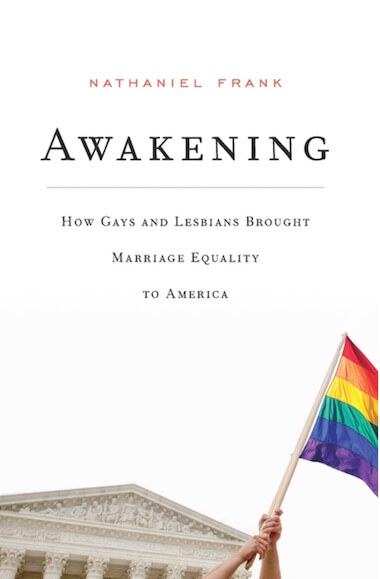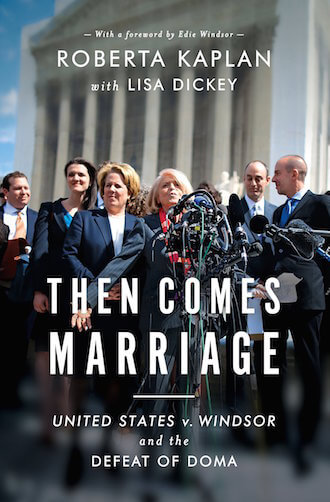Edie Windsor leaves the Supreme Court after oral arguments in her challenge to the Defense of Marriage Act. | DONNA ACETO
The Supreme Court, on March 27, heard oral arguments in Edith (“Edie”) Schlain Windsor’s suit challenging the constitutionality of the 1996 Defense of Marriage Act’s ban on federal recognition of marriages by same-sex couples.
As was the case the day before when the high court took up the challenge to Proposition 8, a good portion of the argument involved arcane procedural questions quite apart from the merits of the issue. Unlike the Prop 8 case, however, the court did not seem to be grabbing onto jurisdictional and standing questions as a way to sidestep a resolution of the underlying matter. While some of the conservative justices may well wish to put off a ruling on the merits, from what transpired in the courtroom, it appeared likely that a majority of the justices are moving toward striking down the 17-year ban on the US government recognizing valid same-sex marriages.
The time devoted to jurisdictional questions in the DOMA case –– though substantial –– may not in the end have the salience it had the previous day in the Proposition 8 argument.
Windsor, a New Yorker, is the surviving spouse of Thea Clara Spyer, her partner of more than 40 years who died in 2009, two years after their marriage in Canada. Though Spyer’s death came prior to New York State’s enactment of marriage equality, in 2008 an intermediate appeals court here established a statewide precedent that legal same-sex marriages from other jurisdictions would be recognized by New York. After her death, the IRS, relying on DOMA, assessed an estate tax of more than $360,000 on Windsor for which she did not enjoy the protection of a marital deduction.
In early 2011, before it responded to Windsor’s complaint, the Obama administration changed its position on DOMA’s constitutionality, which it had earlier defended in other litigation. Attorney General Eric Holder announced that he and the president had concluded that DOMA’s Section 3, which involves the federal recognition issue, violates the Equal Protection Clause and was indefensible. The president, however, ordered the executive branch to continue enforcing the statute until it was either repealed or declared unconstitutional.
In defending the 1996 law in earlier litigation, the administration had contended that DOMA was defensible if subjected to traditional rational basis review –– a judicial standard that presumes a law is constitutional unless those challenging it can show there is no rational justification for it. The Justice Department, in 2011, concluded that discrimination claims based on sexual orientation must be subjected to heightened scrutiny, requiring the government to prove that the law under challenge substantially advances an important government interest. DOMA, the administration argued, fails that test.
DOJ filed a motion to dismiss Windsor’s case in which it asked the district court to declare the statute unconstitutional. (That may be a sentence that warrants more than one read!) The district court ruled that the question of heightened scrutiny need not be considered, since DOMA does not even survive the less searching rational basis test. At the district court, the Bipartisan Legal Advisory Group (BLAG) of the House of Representatives, a group controlled by Republican Speaker John Boehner, was allowed to intervene in the absence of the Justice Department defending the law. Paul Clement, an attorney in private practice, represented BLAG.
The district court ruling on the merits of Windsor’s suit was precisely what the Justice Department wanted, but it appealed the case to the Second Circuit Court of Appeals so that a definitive ruling on DOMA’s constitutionality could be obtained. The Second Circuit, while agreeing with the district court that the statute was unconstitutional, embraced the Justice Department analysis that it was subject to heightened scrutiny. It ordered a tax refund for Windsor, but that order was stayed pending further appeal.
The Case Goes to the Supreme Court
All three parties to the case –– Windsor, the Justice Department, and BLAG — filed petitions for Supreme Court review, and DOJ’s petition was granted in December. The other petitions, as well as ones filed in separate DOMA cases that are pending, were not acted on.
The high court added questions to the case when it granted the government’s petition. First, since the government did not disagree with the Second Circuit ruling, the court asked whether there was a real “case or controversy,” as required by precedent. The court only takes on cases where the parties have a conflict that needs resolution; it does not issue mere advisory opinions.
The other question was whether BLAG, which lower courts had allowed to intervene in the case, had “standing” to defend the law in an appellate proceeding.
The Supreme Court recognized that all the parties had an interest in a resolution on the merits, so it appointed Harvard Law School Professor Vicki Jackson to act as friend of the court to argue in support of the proposition that the court lacks jurisdiction in the case and that BLAG lacks standing to participate.
Procedural Argument
Jackson was given substantial time –– almost half an hour –– to make her argument, followed by extensive argument from Clement, representing BLAG, and Deputy Solicitor General Sri Srinivasan. Those sitting in the courtroom, no doubt eager to hear arguments about the constitutionality of DOMA, were instead subjected to nearly an hour of arcane federal jurisdictional and procedural jargon. The primary interest during this portion of the morning came in searching for signals about how the justices might come out on the threshold questions of jurisdiction and standing.
Review of the transcript and the audio recording leaves me with the impression that the more conservative justices, reading the tea leaves and knowing DOMA is a loser on the merits, would like to see the case dismissed on jurisdictional grounds. The moderate to liberal justices, eager to strike down Section 3, are willing to accept the Justice Department’s somewhat strained argument that there is a real “case or controversy” here –– that the government is an “aggrieved party” on the losing end of an appellate decision ordering it to dispense $363,000 from the federal treasury.
As usual, all eyes and ears were on Justice Anthony Kennedy, the potential tie-breaker.
Kennedy’s first interjection in the argument suggested he will line up with those finding a basis for jurisdiction. After Jackson said the government faces the same requirement of showing “injury” as any of party on appeal, he said, “But it seems to me there’s an injury here.”
From there, Justice Elena Kagan picked up the ball, stating, “To go back to Justice Kennedy’s point, we have injury here in the most classic, most concrete sense. There’s $300,000 that’s going to come out of the government’s treasury if this decision is upheld, and it won’t if it isn’t.”
That got the conversation rolling.
Those justices inclined to find jurisdiction emphasized that there was something real at stake here –– not just Windsor’s tax refund but the rights of married same-sex couples under more than 1,100 provisions of federal law for which marital status is relevant.
Chief Justice John Roberts, in a bit of an exasperated tone, questioned the president’s posture in continuing to enforce DOMA while refusing to defend it on constitutional grounds, asking why Obama did not have the “courage” to act on his convictions and order the government to stop enforcing Section 3. In questioning Srinivasan, he asserted the Justice Department was “asking us to do something we have never done before to reach the issue in this case.”
Some of Roberts’ colleagues may be unmoved by his complaint. The late Justice William Brennan was fond of saying, “You can do anything you like around here if you can count to five,” so if a majority of the justices find that there is a real “case and controversy” before them, they are likely to find they have jurisdiction, regardless of precedent.
The justices spent so much time grilling Jackson about the “case or controversy” question she was unable to get to the issue of BLAG’s “standing” at any length. That question played out mainly in the arguments by Srinivasan and Clement.
In her written brief, however, Jackson argued that BLAG did not have standing, and that in its absence, the case lacked “adverseness” on the question of DOMA’s constitutionality. In her view, that contributed to the court’s lack of jurisdiction.
The time devoted to jurisdictional questions in the DOMA case –– though substantial –– may not in the end have the salience it had the previous day in the Proposition 8 argument. On Prop 8, it appeared that there might be substantial support for avoiding the merits of whether same-sex couples have a constitutional right to marry by disposing of the case on jurisdictional grounds. With DOMA, the jurisdictional issues did not loom so heavily, since it appeared there might be a majority for striking down DOMA and that the justices in that majority would find a rationale for asserting jurisdiction and getting to the merits.
Argument on the Merits
When the justices turned to the merits, Clement sought to frame the case as one about “federalism” rather than an equal protection case. He contended that both the states and the federal government have sovereign authority for defining marriage for their own purposes. He also argued that prior to Congress’ enactment of DOMA in 1996, any statute it adopted that made reference to marriage did so with the traditional understanding of an opposite-sex institution. DOMA, he asserted, merely formalized that understanding in a definition.
Justice Ruth Bader Ginsburg immediately led the charge for those inclined to strike down DOMA, suggesting that a state law marriage denied all federal benefits would be distinctly inferior to one with such benefits. In other words, the federal government was not merely defining marriage for its own purposes, it was inevitably setting the terms by which states could confer full marriage rights on their residents.
For those waiting to see if Kennedy would show his hand, he soon did. Clement insisted that Congress did not interfere with the right of states to define marriage. “It would obviously be a radically different case,” he said, “if Congress had, in 1996, decided to try to stop states from defining marriage in a particular way or dictate how they would decide it in that way.”
Kennedy did not accept Clement’s distinction as so cut and dry.
“Well,” he said, “it applies to over what, 1,100 federal laws, I think we are saying? So it’s not — I think there is quite a bit to your argument that if the tax deduction case, which is specific, whether or not if Congress has the power it can exercise it for the reason that it wants, that it likes some marriage, I suppose it can do that. But when it has 1,100 laws, which in our society means that the federal government is intertwined with the citizens’ day-to-day life, you are at real risk of running in conflict with what has always been thought to be the essence of the state police power, which is to regulate marriage, divorce, custody.”
Kennedy then challenged Clement’s argument that DOMA was about maintaining uniformity for purposes of federal law, stating, “Well, but it’s not really uniformity because it regulates only one aspect of marriage. It doesn’t regulate all of marriage.”
Later in the argument, Kennedy returned to a point that seemed to have struck him with particular force during the Prop 8 proceeding the day before, referring to “the right of children” –– his shorthand for invoking the disadvantages children might suffer if their parents’ marriage were not recognized for federal purposes.
Ginsburg picked up on Kennedy’s argument about the degree to which the federal government’s definition of marriage becomes intertwined in the lives of couples recognized as married by their states. When Clement asserted that one of DOMA’s functions was to avoid having the states expand the class of people eligible for federal benefits by allowing same-sex marriages, she stepped in, stating, “They’re not a question of additional benefits. I mean, they touch every aspect of life. Your partner is sick. Social Security. I mean, it’s pervasive. It’s not as though, well, there’s this little federal sphere and it’s only a tax question. It’s, as Justice Kennedy said, 1,100 statutes, and it affects every area of life. And so you are really diminishing what the state has said is marriage. You’re saying, no, state said two kinds of marriage –– the full marriage and then this sort of skim milk marriage.”
Kagan suggested the uniformity argument was disingenuous.
Kagan then brought the point home, saying that prior to DOMA’s passage, “the only uniformity that the federal government has pursued is that it’s uniformly recognized the marriages that are recognized by the state.”
Kagan suggested the uniformity argument was disingenuous, saying, “So, this was a real difference in the uniformity that the federal government was pursuing. And it suggests that maybe something — maybe Congress had something different in mind than uniformity. So we have a whole series of cases which suggest the following, which suggest that when Congress targets a group that is not everybody’s favorite group in the world, that we look at those cases with some — even if they’re not suspect [and therefore deserving of heightened scrutiny protection] — with some rigor to say, do we really think that Congress was doing this for uniformity reasons, or do we think that Congress’ judgment was infected by dislike, by fear, by animus, and so forth?”
That point shifted the argument back to the history surrounding DOMA’s enactment, and led Kennedy to raise the federalism issue that may be his bottom line in this case: “The question is whether or not the federal government, under our federalism scheme, has the authority to regulate marriage.”
Clement insisted that DOMA was not regulating marriage, merely defining it for purposes of federal law, but Kennedy and the liberal justices clearly felt this argument did not stand up very well. Federal law, as Kennedy asserted, is “intertwined” with the everyday lives of people, especially when it comes to economic issues such as Social Security, taxes, and public benefits law. In all those areas, marital status can make a big difference.
When Solicitor General Donald Verrilli, Jr., got up to argue, Chief Justice Roberts sought to engage him in an extended and rather pointless colloquy about federalism and the limits of Congress’ power to define terms used in federal statutes, but Verrilli was able to get to his main points about DOMA’s discriminatory impact.
Justice Samuel Alito posed an interesting hypothetical question that suggested that federal recognition of same-sex marriage allowed in only some of the states might have its own equal protection problems. He posited three soldiers with same-sex civilian partners –– one married, one in a civil union, one in a committed relationship in a state that provided neither legal status –– and asked Verrilli whether in all three cases the civilian partner would be entitled, under the government’s argument, to be notified in the event the soldier was wounded. Even if DOMA were struck down, Verrilli conceded, only the married spouse would be entitled to such notification.
Verrilli then sought to refocus the discussion on the harm DOMA does, saying, “The question in the case is whether Congress has a sufficiently persuasive justification for the exclusion that it has imposed. And it does not. The only way in which BLAG’s arguments for the constitutionality of this statute have any prospect of being upheld is if the court adopts the minimal rationality standard.”
Acknowledging, then, that DOMA might survive the most lenient form of judicial scrutiny, the solicitor general argued that due to the government’s history of anti-gay discrimination, laws that make distinctions based on sexual orientation must be subjected to heighted scrutiny.
Chief Justice Roberts sought to rehabilitate BLAG’s argument against heightened scrutiny by highlighting the gay rights movement’s recent political successes, suggesting that gay people can achieve their rights through the normal legislative process without the assistance of heightened scrutiny in constitutional litigation. And in a brief rebuttal, Clement picked up on that point when he made a plea that the court allow the issue of gay marriage to be resolved through the political process. It was very much an echo of the closing argument Charles Cooper made the day before on behalf of the Proponents of Prop 8.
Roberta Kaplan’s advocacy for Windsor proved successful at the district court and at the Second Circuit Court of Appeals, but the Supreme Court gave her only brief argument time toward the end of the morning. Unlike the solicitor general, she asserted that DOMA “fails even under rationality review. Because of DOMA, many thousands of people who are legally married under the laws of nine sovereign states and the District of Columbia are being treated as unmarried by the federal government solely because they are gay.”
Roberts and then Justice Antonin Scalia tried to drag Kaplan back into the federalism arguments that had been posed to Verrilli, asking whether Congress has authority to adopt a federal definition of marriage that includes same-sex couples for purposes of federal benefits applied uniformly throughout the country, even in states that do not recognize any legal status for same-sex partners.
Here, Kaplan was cautious in not pressing for a resolution that went beyond her client’s circumstances.
“I think the federal government could extend benefits to gay couples to equalize things on a programmatic basis to make things more equal,” she responded. “Whether the federal government can have its own definition of marriage, I think, would be very closely argued whether that’s outside the enumerated approach.”
Kaplan seemed to be saying that only the states can decide who can marry. After some intense back and forth with Scalia, she concluded by saying, “I’m not sure the federal government can create a new federal marriage that would be some kind of marriage that states don’t permit.”
Alito stayed on this issue, and Kaplan reinforced her narrow framing of the issue. In essence, Alito was asking whether federal recognition would extend to couples who were legally married in one state but lived in another that did not recognize their marriage.
“Our position is only with respect to the nine states — and I think there are two others that recognize those marriages,” she replied. “So if my client — if a New York couple today marries and moves to North Carolina, one of which has a state constitutional amendment — and one of the spouses dies, they would not — and estate taxes determine where the person dies –– they would not be entitled to the deduction. That is not our claim here.”
The political attack on DOMA is broader than that. The Respect for Marriage bill that New York Congressman Jerry Nadler has introduced would repeal DOMA and give federal recognition to any marriage legally contracted, regardless of where the couple actually lives. It’s worth considering whether Alito’s question raises a red flag about whether that provision in Nadler’s bill would create federalism questions in the courts.
Justice Stephen Breyer lent Kaplan a hand by asking her to respond to Clement’s argument that by passing DOMA Congress was attempting to stay out of the same-sex marriage controversy while the states weighed the issue.
“Congress did not stay out of it,” she responded. “Section 3 of DOMA is not staying out of it. Section 3 of DOMA is stopping recognition by the federal government of couples who are already married, solely based on their sexual orientation, and what it’s doing is undermining, as you can see in the briefs of the State of New York and others, it’s undermining the policy decisions made by those states that have permitted gay couples to marry.”
Roberts pressed Kaplan to concede that the gay community had gained considerable political power since DOMA was enacted, but she resisted, stating, “I don’t believe that societal understanding came strictly through political power, and I don’t think that gay people today have political power as that — this Court has used that term with — in connection with the heightened scrutiny analysis.”
Prognostication and the Road Ahead
In the immediate post-argument media commentary, consensus emerged that the court was likely to conclude it has jurisdiction and to rule, by a vote of at least 5-4, that Section 3 of DOMA violates the Equal Protection Clause. As with any reading of oral arguments, however, that consensus must necessarily be provisional.
Kennedy’s remarks did not reflect the kind of indecision he signaled during the Prop 8 argument, probably because a decision striking down DOMA’s Section 3 seems a smaller step and because the equal protection violation here seems so clear on its face.
Breyer briefly raised the question whether there was a principled way to rule for Windsor on DOMA but not for the plaintiff same-sex couples in the Prop 8 case. The discussion on that point did not go very far.
Breyer’s question, however, is a fair one since the justifications members of Congress articulated for enacting DOMA in 1996 sound much like the arguments Cooper made this week in support of Prop 8. If the court finds that DOMA does not even survive rational basis review, that would be a useful precedent for those litigating same-sex marriage cases in other states.
For now, though, both cases head back behind closed doors until the court renders its decisions, probably in June.


































